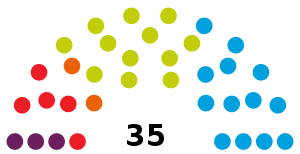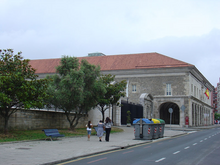Parliament of Cantabria
Parliament of Cantabria Parlamento de Cantabria Asamblea Regional de Cantabria | |
|---|---|
Cantabria unicameral legislature | |
| Type | |
| Type | Spanish regional legislature |
| Houses | Unicameral |
| Structure | |
| Seats | 35 |
 | |
Political groups | Government (17)
Supported by (3)
Opposition (15)
|
Length of term | 4 years |
| Elections | |
Last election | May 24, 2015 |
Next election | 2019 |
| Meeting place | |
 | |
| The Parliament of Cantabria in Santander | |
| Website | |
| http://www.parlamento-cantabria.es | |
The Parliament of Cantabria is the legislative body of the Autonomous Community of Cantabria. The task of the Members of the Parliament is to represent the Basque citizens. They are elected by, equal, free, direct, non-secret and universal suffrage.
Contents
1 Building
2 Transparency
3 Elections and voting
4 See also
5 References
Building
The building where the Parliament of Cantabria is placed is the old hospital of Saint Rafaael, in the High Street (old district) of Santander, Spain.
The hospital was built in 1791 as a charity hospital for poors and main hospital of Santander. It served during the Independence War and the disaster of the Cabo Machichaco. The hospital closed down in 1928, and in 1982, the regional assembly of Cantabria started the restoration project of the building, which ended in 1984 and won some awards.
Transparency
The Parliament of Cantabria is one of the most transparent regional parliaments in Spain (98,8%).[1]
All the students of Cantabria go to the Parliament at least once on a school trip, where they meet some deputies and usually the President of the Parliament. They are told about the history of the building, how the Parliament works and how they can participate in democracy. Sessions are retransmitted by the regional television broadcaster Tele Bahía.
Elections and voting
The number of seats in the Parliament of Cantabria is set to a fixed-number of 35. All Parliament members are elected to a four-year term in a single multi-member district, consisting of the Community's territory (the province of Cantabria), using the D'Hondt method and a closed-list proportional representation system.
Voting is on the basis of universal suffrage in a secret ballot. Only lists polling above 5% of valid votes in all of the community (which include blank ballots—for none of the above) are entitled to enter the seat distribution.[2]
The first elections were held in 1983 when the People's Coalition won a majority of seats and José Antonio Rodríguez became the first regional president. In the most recent elections, held on 24 May 2015 the People's Party was returned with a majority of 1 over the Regionalist Party of Cantabria.[3] The next elections are expected to be held in 2019.
See also
- List of Presidents of the Parliament of Cantabria
References
^ "Archived copy" (PDF). Archived from the original (PDF) on 2014-09-03. Retrieved 2014-09-01.CS1 maint: Archived copy as title (link) .mw-parser-output cite.citationfont-style:inherit.mw-parser-output qquotes:"""""""'""'".mw-parser-output code.cs1-codecolor:inherit;background:inherit;border:inherit;padding:inherit.mw-parser-output .cs1-lock-free abackground:url("//upload.wikimedia.org/wikipedia/commons/thumb/6/65/Lock-green.svg/9px-Lock-green.svg.png")no-repeat;background-position:right .1em center.mw-parser-output .cs1-lock-limited a,.mw-parser-output .cs1-lock-registration abackground:url("//upload.wikimedia.org/wikipedia/commons/thumb/d/d6/Lock-gray-alt-2.svg/9px-Lock-gray-alt-2.svg.png")no-repeat;background-position:right .1em center.mw-parser-output .cs1-lock-subscription abackground:url("//upload.wikimedia.org/wikipedia/commons/thumb/a/aa/Lock-red-alt-2.svg/9px-Lock-red-alt-2.svg.png")no-repeat;background-position:right .1em center.mw-parser-output .cs1-subscription,.mw-parser-output .cs1-registrationcolor:#555.mw-parser-output .cs1-subscription span,.mw-parser-output .cs1-registration spanborder-bottom:1px dotted;cursor:help.mw-parser-output .cs1-hidden-errordisplay:none;font-size:100%.mw-parser-output .cs1-visible-errorfont-size:100%.mw-parser-output .cs1-subscription,.mw-parser-output .cs1-registration,.mw-parser-output .cs1-formatfont-size:95%.mw-parser-output .cs1-kern-left,.mw-parser-output .cs1-kern-wl-leftpadding-left:0.2em.mw-parser-output .cs1-kern-right,.mw-parser-output .cs1-kern-wl-rightpadding-right:0.2em
^ "Ley 5/1987, de 27 de marzo, de elecciones al Parlamento de Cantabria" [Law 5/1987, of 27 March, of elections to the Parliament of Cantabria]. Noticias Juridicas (in Spanish). Retrieved 2017-01-13.
^ "Resultados Electorales detalladoes Canatabria" [Detailed Election Results Cantabria]. www.argos.gva.es. Archivo Histórico Electoral [Electoral History Archive] (in Spanish). ARGOS. 2015. Retrieved 2017-01-13.
Coordinates: 43°27′35″N 3°48′49″W / 43.45972°N 3.81361°W / 43.45972; -3.81361
